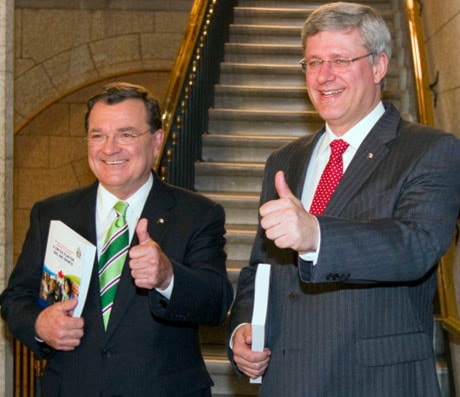OTTAWA — Cash for Quebec and a lump of coal for their political rivals are the only new elements Conservatives have dished up in a reprised federal budget that mirrors the one delivered barely two months ago.
Armed with a majority mandate, Prime Minister Stephen Harper is forging ahead with a 2011-12 budget larded with low-cost boutique tax breaks, modest pension help for the poorest seniors, and a vow to slay the deficit within four years.
New to the spending blueprint is $2.2 billion for Quebec as an inducement to finalize full harmonization of the provincial sales tax with the federal GST.
The budget will also phase out the $2-per-vote public subsidy received by all federal political parties, a measure that will leave parties almost fully reliant on taxpayer-subsidized private donations — and hurt opposition parties far more than the cash-rich Conservatives
Finance Minister Jim Flaherty claimed cutting the per-vote subsidy will increase “integrity and accountability.”
All the moves were repeatedly linked to the majority mandate the Conservatives won May 2, when 39.6 per cent of voters delivered them 166 seats in the House of Commons.
“A month ago the people spoke,” Flaherty told the Commons in a brief budget speech Monday. “Through their democratic power they clearly signalled the need for a principled, stable government at this challenging but promising moment in our nation’s history.”
Flaherty’s speech referred again and again to the voter endorsement — and snidely noted that MPs who “took the time to read the March budget” won’t find anything surprising in the new document.
They also won’t find a single detail of some $4 billion in promised annual spending cuts, an omission that left NDP Leader Jack Layton fuming.
“The government on purpose is not telling Canadians what it’s going to cut because it knows it will be unpopular for doing so,” he said outside the House.
“I would’ve hoped we’d have more transparency.”
Layton said his official Opposition “is going to ... root out what it is that the government’s up to.”
Liberal Leader Bob Rae said the budget reminded him of a groundhog he saw on the lawn of Parliament Hill.
“There was a very happy, well-fed groundhog that was just, you know, lying around, twiddling its thumbs, looking very complacent, very well-fed, very happy,” said Rae, adding the “groundhog budget” had the “same spirit of complacency.”
At least one Liberal was happy with the budget, albeit a provincial one. Quebec Finance Minister Raymond Bachand hailed the money for a sales tax deal.
“This is a good day for Quebec,” he said. “A major step has been crossed.”
Among the fiscal changes since the March 22 budget, Canada’s deficit for last year has been revised downward to $36.3 billion from $40.5 billion. But this year’s red ink has been revised upward to $32.3 billion from $29.6 billion.
The difference relates mainly to a decision to allow infrastructure projects under the recession-fighting stimulus plan to be extended until the fall, with the funding falling out of 2010 and into 2011.
The budget notes that over the two-year period, the budgetary deficit is actually $1.6 billion less than was charted in March, and the government is continuing to say the nation’s books will be balanced by 2014-15.
Total federal spending, including public debt charges, will total $281.4 billion this fiscal year.
But Flaherty noted that only about $80 billion of that total is earmarked for strategic review — meaning some $4 billion in promised annual cuts equates to five per cent.
“In the private sector, this would be viewed as not very ambitious,” he added.
A hard new edge to the Conservative deficit-slashing commitment has emerged with the majority mandate, judging by Flaherty’s comments to reporters. A government that said much of the $4 billion in savings would come from civil service attrition is now flatly asserting that programs will come under the knife.
“There will be some programs that will not continue. There’s no question about that.”
Although the nature of the cuts has not been laid out, they will be in the next federal budget, said Flaherty. In the meantime, voters get what they voted for, he said.
“We just had an election on May and the results speak for themselves.”
Both the per-vote subsidy cut and the Quebec harmonization cash were promised by the Conservatives during the April election campaign that led to Harper winning the first federal Conservative majority since 1988.
Among the measures reintroduced from the March 22 budget:
— $400 million to extend the ecoENERGY Retrofit-Homes program for one year. The program offers rebates to help make homes more energy efficient.
— A top-up benefit of up to $600 for single, low-income seniors and up to $840 for couples through the Guaranteed Income Supplement. Expected to cost more than $300 million a year.
— A Family Caregiver Tax Credit which would save about $300 a year for people caring for sick or disabled relatives.
— A Children’s Arts Tax Credit for children’s arts, culture, recreation and developmental activities which would save parents about $75 a year per child.
— An initiative to attract health-care workers to rural and remote communities by forgiving up to $40,000 in student loans for doctors and $20,000 for nurses.
— Legislation to make the $2-billion Gas Tax Fund permanent to provide predictable infrastructure funding for municipalities.
